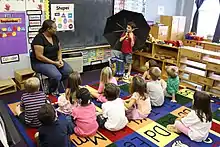Show and tell
Show and tell (sometimes called show and share or sharing time) is the practice of showing something to an audience and describing it to them, usually a toy or other children's-oriented item. In the United Kingdom, North America, New Zealand and Australia, it is a common classroom activity in early elementary school.[1] In a typical session of show and tell, a child will bring an item from home and will explain to the class why they chose that particular item, where they got it, and other relevant information.

The exact origins of show and tell are unknown, but it was written about as early as 1954 in the journal Childhood Education.[2] Show and tell is used to develop storytelling ability, bridge school and home, forge connections and bonds between students, help teachers to gain a better understanding of their students, and enhance student's communication skills, including around feelings.[2][3] It can also be used to build public speaking skills such as voice projection and poise.[4] Variants of show and tell have been used to teach vocabulary.[5] Although often thought of as an activity for younger children, teachers have described successfully bringing it into classrooms of students in middle and even secondary grades.[4][6][7] The name has also been used to describe other educational practices, such as a way for students to demonstrate mathematical thinking.[8]
The teacher's role in show and tell can vary. The teacher may suggest a theme for the objects, such as particular vocabulary words.[5] During the presentation of the object, some teachers do minimal guidance, while other teachers take a more active role in preparing students for the activity, helping students give a successful share, and in guiding questions and comments from other students.[9] A 1994 paper found more involved teaching can lead to better psychological gains for students than a more passive approach.[9]
A 2014 study found over 50 picture books about show and tell.[2]
Show and tell has been criticized for the amount of time it takes, monotony, and for penalizing shy students.[10]
See also
References
- Ammer, Christine. (1997). "show and tell," The American Heritage dictionary of idioms, p. 580.
- Mortlock, Anita (November 2014). "Children's narratives at 'show-and-tell': What do the storybooks tell us about being known, being better and being judged?". Hekupu. Retrieved 2021-03-02.
- Oken-Wright, Pamela (1988). "Show-and-Tell Grows Up". Young Children. 43 (2): 52–58. ISSN 0044-0728. JSTOR 42726052.
- Nelson, Dorothy H. (1976). "D. and E.: Show and Tell, Grown Up". Language Arts. 53 (2): 203–205. ISSN 0360-9170. JSTOR 41404130.
- Laner, Karen (1986). "Show and Tell: Alive and Well". The Reading Teacher. 39 (8): 869–870. ISSN 0034-0561. JSTOR 20199247.
- Camp, Donna J.; Tompkins, Gail E. (1990). "Show and tell in middle school?". Middle School Journal. 21 (4): 18–20. doi:10.1080/00940771.1990.11495079. ISSN 0094-0771. JSTOR 23023756.
- Gump, Steven E. (2006). "Quick Fix: Productively Waiting for Latecomers". College Teaching. 54 (1): 181. doi:10.3200/CTCH.54.1.181-208. ISSN 8756-7555. JSTOR 27559256. S2CID 143875835.
- Hafner, Anne L. (2016-06-23). "Teaching-Method Scales and Mathematics-Class Achievement: What Works With Different Outcomes?". American Educational Research Journal. 30: 71–94. doi:10.3102/00028312030001071. S2CID 144173383.
- Alsafi, Abdullah T. (1994). "Psychological Reality and the Role of the Teacher in Early-Education Sharing Time". International Review of Education. 40 (1): 59–69. Bibcode:1994IREdu..40...59A. doi:10.1007/BF01103004. ISSN 0020-8566. JSTOR 3444286. S2CID 143476489.
- Timberlake, Pat (1973). "I Hate Show and Tell!". Elementary English. 50 (4): 651–652. ISSN 0013-5968. JSTOR 41388040.